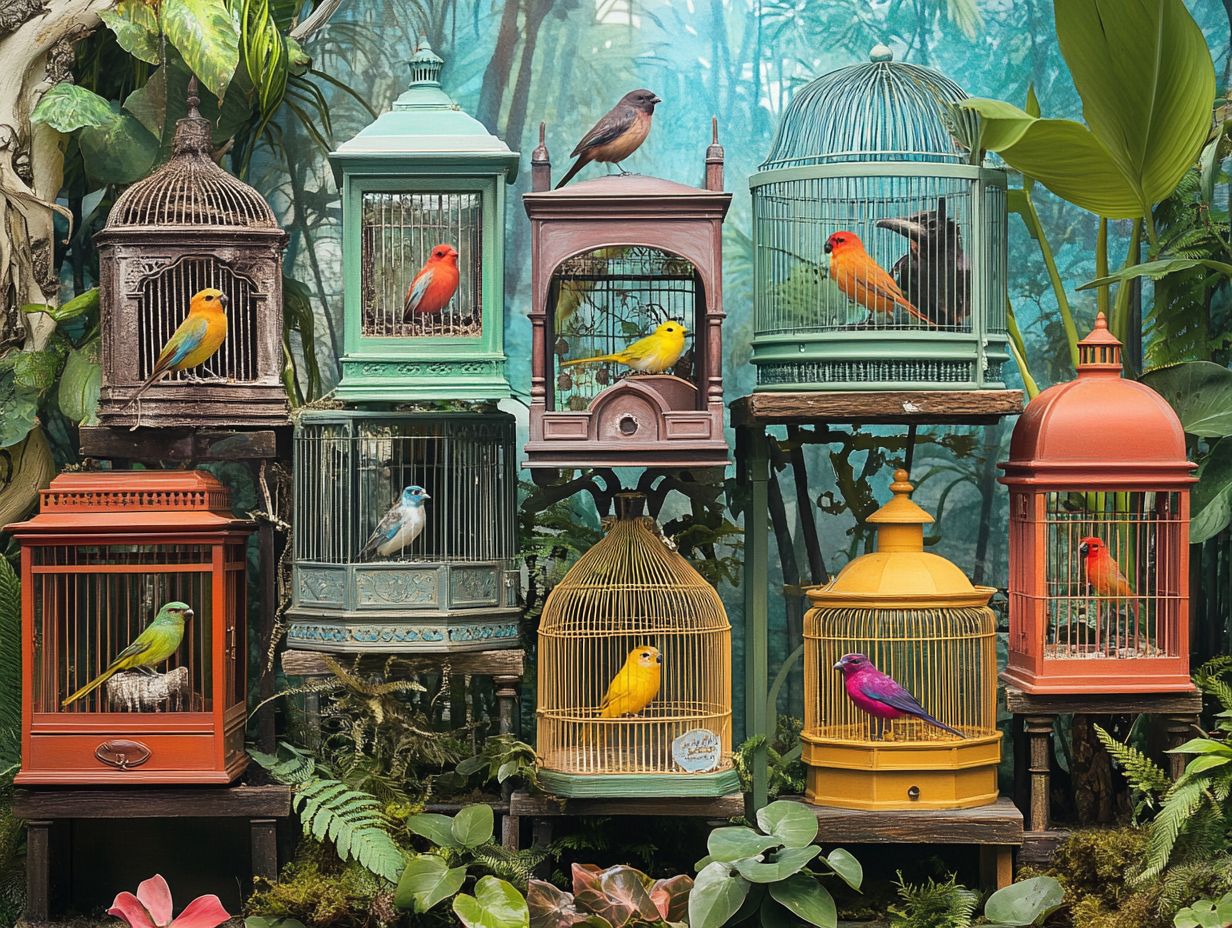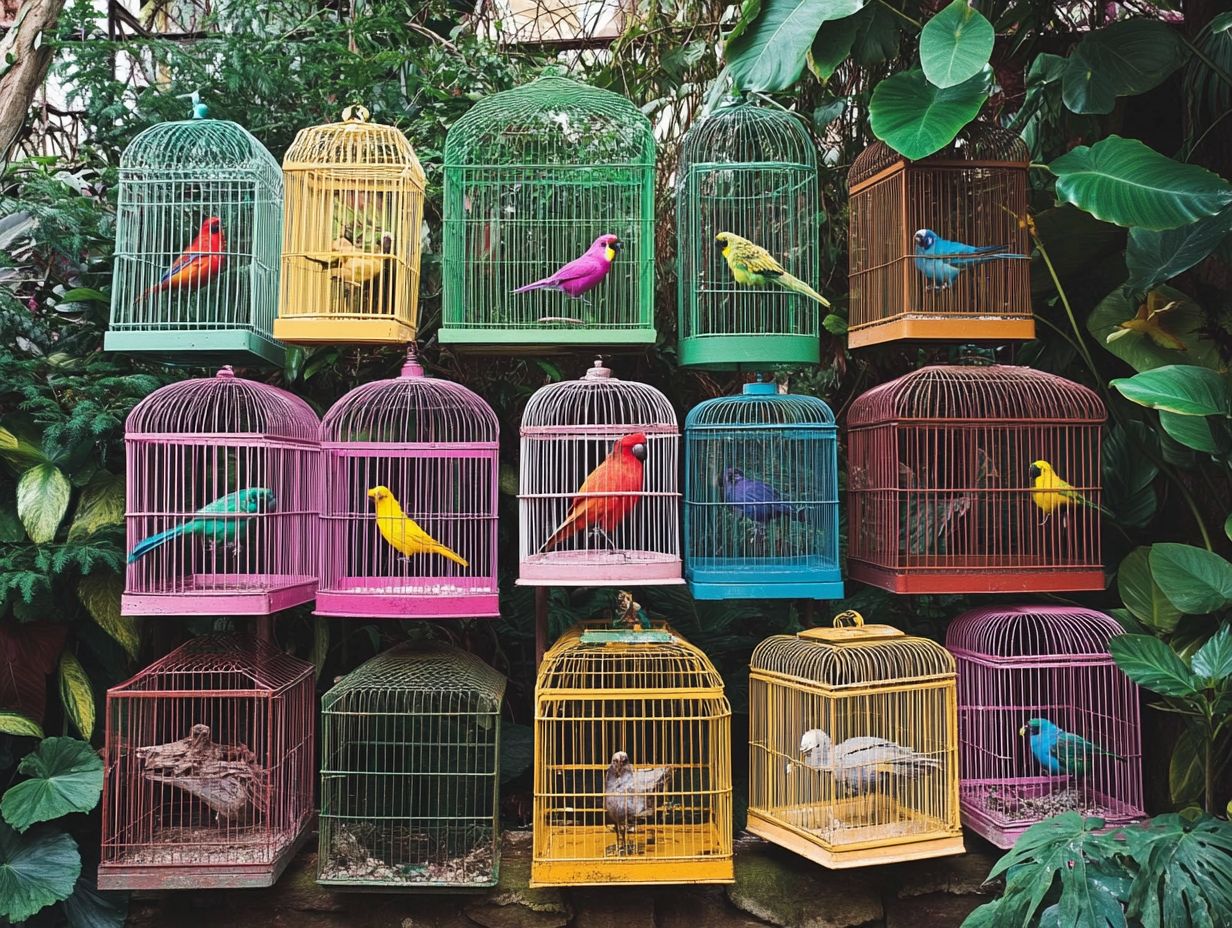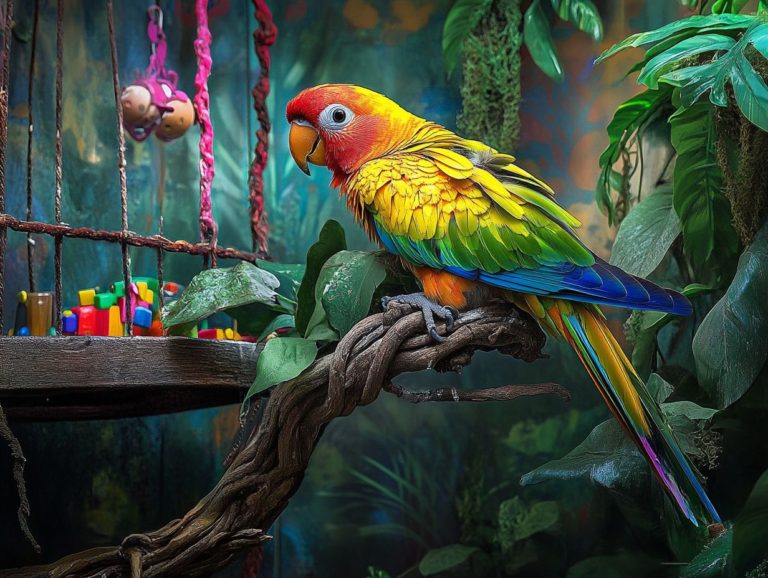Cage Size Requirements for Different Birds
Choosing the right cage size for your feathered friend is essential for their health and happiness. Each bird species has unique space requirements, and understanding these needs can significantly enhance their quality of life.
This guide details the ideal cage sizes for small, medium, and large birds, providing specific examples and minimum size recommendations. Whether you’re a seasoned bird owner or just starting your journey into the avian world, this information will empower you to create the perfect home for your pet.
Contents
- Key Takeaways:
- Understanding Bird Cage Sizes
- Cage Size Requirements for Small Birds
- Cage Size Requirements for Medium Birds
- Cage Size Requirements for Large Birds
- Creating a Stimulating Environment
- Frequently Asked Questions
- What are the recommended cage size requirements for small birds?
- Do larger birds have different cage size requirements?
- Can I keep multiple birds in one cage?
- What should be included in a bird’s cage?
- Are there any specific requirements for cage bar spacing?
- Are there any exceptions to cage size requirements?
Key Takeaways:

- Choosing the right cage size is crucial for the health and well-being of your pet bird.
- Small birds like finches and canaries need a minimum cage size of 18x18x18 inches, while larger birds like cockatiels and conures require at least 24x24x24 inches.
- Large birds like macaws and cockatoos need even larger cages, with minimum recommendations of 36x36x48 inches. Provide ample space and enrichment for a happy and healthy bird.
Understanding Bird Cage Sizes
Understanding bird cage sizes is vital for you as a bird owner aiming to create the optimal living environment for your feathered companions. Selecting the right cage size keeps them healthy and significantly impacts their mental health and happiness.
You must take into account factors such as wingspan requirements, suitable bar spacing (the distance between the bars of the cage, which should be small enough to keep birds safe), and the necessity for flight space. This is essential for creating a habitat that meets their basic needs.
Factors to Consider
When determining the ideal cage size for your pet birds, consider their specific species, wingspan needs, and the appropriate bar spacing to ensure both safety and comfort. For detailed guidance, check out how to choose the right cage for my bird. Different bird sizes come with unique requirements.
For instance, small birds may need less space, but they thrive in environments allowing for flight and movement. Medium to large birds require ample room for flying and to accommodate their powerful beaks and natural behaviors.
Think about cleaning considerations; larger cages might require more upkeep but often allow for better air circulation and easier management of bird droppings. Maintaining an engaging environment is also crucial; providing interactive toys and enrichment activities necessitates extra space, helping to keep birds mentally stimulated and active, which is essential for their overall well-being.
Cage Size Requirements for Small Birds
Cage size requirements for small birds can differ remarkably depending on their species and behaviors. As a bird owner, choosing the right cage for your pet bird is vital to provide sufficient living space, an area for activity, and opportunities for social interaction.
This thoughtful approach promotes both their health and happiness.
Examples of Small Birds

Some popular examples of small birds include Cockatiels, Green-Cheeked Conures, and Parakeets. Each requires specific cage sizes tailored to their unique behaviors and overall happiness.
These delightful creatures possess distinct characteristics that make them captivating companions. From the playful antics of the Green-Cheeked Conure to the gentle nature of Cockatiels, there s no shortage of charm. Understanding their ideal living conditions is essential for their mental and physical well-being, as they thrive in environments that offer ample space, natural light, and safe areas for exploration.
Socialization plays a vital role as well; small birds often flourish with the company of their kind or through human interaction, which nurtures their vibrant personalities. Bonding behaviors, such as mutual grooming or affectionate chirping, are crucial for their emotional well-being. Providing interactive toys stimulates their innate curiosity and offers the enrichment they need to thrive.
Act now to ensure your feathered friend thrives in their perfect space!
Minimum Cage Size Recommendations
For small birds, the minimum cage size recommendations typically suggest a width of at least 18 inches and a height of 24 inches. This ensures your feathered companions have enough living space to engage in their lively antics.
This size allows them to stretch their wings and move freely, which is crucial for their physical health and emotional well-being. When selecting a habitat, pay close attention to the bar spacing; it should be no wider than 1/2 inch to prevent escapes or injuries.
Optimizing the cage’s interior is just as important. Provide natural wood perches at various heights, bird toys that encourage climbing and swinging, and ample space for grooming. These arrangements promote exercise and reduce stress, contributing to your small avian friends’ happiness and health.
Cage Size Requirements for Medium Birds
Cage size requirements for medium birds are crucial for providing these delightful companions with the space they need to flourish. Experts often recommend a minimum dimension of 24 inches in width and 30 inches in height. For more detailed guidance, consider choosing the right cage shape for your bird, as this ensures your feathered friends can move and engage in social interactions.
By adhering to these guidelines, you create an environment where your birds can truly thrive.
Examples of Medium Birds
Examples of medium birds include Amazon Parrots and Quaker Parrots, both of which require appropriately sized cages. These species flourish in environments that offer plenty of space for climbing, flying, and exploring.
It s vital to ensure their cages mimic aspects of their natural habitat by incorporating elements like perches, swings, and ramps.
Beyond physical space, the emotional needs of these birds are significant; they are social beings that thrive on regular interaction with their owners and other birds. Engaging toys are essential for keeping them stimulated and reducing boredom.
Provide a mix of challenging puzzles and foraging opportunities to enhance their quality of life.
Medium Birds Cage Requirements

For medium birds, it’s generally recommended that you provide a cage with a minimum width of 24 inches and a height of 30 inches. This ensures they have enough room to move and socialize comfortably.
This generous space is vital for their physical and mental well-being, as these vibrant creatures flourish on interaction and environmental stimulation. Thoughtfully arranging the cage with bird perches of various diameters and heights encourages exercise and mimics their natural behaviors.
Incorporating diverse toys that engage both their minds and bodies like foraging opportunities and climbing structures is essential for fostering strong bonding behaviors. Together, these elements create an enriching environment that enhances their quality of life.
Cage Size Requirements for Large Birds
Cage size requirements for large birds are of utmost importance. Creatures like Macaws and Cockatoos require ample space to thrive, given their size and energetic nature.
It s often recommended that their cages have a minimum width of 36 inches and a height of 48 inches. This ensures they have the room they need to stay healthy and happy.
Creating a Stimulating Environment
To create a stimulating environment, avoid harmful materials and overcrowding. Regularly rotate toys and rearrange perches to keep your birds engaged.
Choose a cage today, and see your birds thrive like never before!
Examples of Large Birds
Examples of large birds like macaws and cockatoos highlight the need for substantial cage sizes to ensure their health, happiness, and ability to engage in natural behaviors.
These stunning birds are not just beautiful; they bring joy and life to any home! They require a variety of different living conditions to truly thrive. A spacious living area is essential, as it mimics their natural habitat and allows for free movement. Providing an assortment of interactive toys such as ropes, swings, and puzzles stimulates their minds and encourages physical activity.
These engaging activities are crucial for warding off boredom, which can lead to destructive behaviors.
Large birds thrive in social environments, making interaction with their owners or other birds vital for their overall well-being.
Minimum Cage Size Recommendations
Large birds need a minimum cage size of 36 inches wide and 48 inches high. This size provides them with the necessary living and flight space to thrive as dynamic companions.
It’s essential to customize the cage setup to reflect their natural habitats, ensuring they have ample room to move about and stretch their wings. To promote their physical and mental well-being, incorporate flight branches and perches at various heights to encourage climbing and exploration.
Don’t forget to include interactive toys like foraging puzzles, swings, and ladders! These will stimulate their curious minds and keep them happily engaged. A thoughtfully designed environment facilitates exercise and fosters a sense of security, ultimately contributing to the overall health of your remarkable avian friends.
Frequently Asked Questions

What are the recommended cage size requirements for small birds?
For small birds such as finches, canaries, and budgies, the recommended cage size is at least 18 inches by 18 inches by 18 inches. This size will give them enough room to fly and exercise.
Do larger birds have different cage size requirements?
Yes, larger birds like parrots and cockatiels require a bigger cage. The minimum recommended size for these birds is 24 inches by 24 inches by 24 inches. However, the bigger the cage, the better it is for their overall well-being.
Can I keep multiple birds in one cage?
It is not recommended to keep multiple birds in one cage, especially if they are of different species. Each bird should have its own space to avoid potential conflicts and ensure they have enough room to move and exercise.
What should be included in a bird’s cage?
To meet the basic needs of bird species, it is crucial to consider not just the cage size but also the provision of a suitable feeding station and bird-proof environments to keep your feathered friends safe.
Apart from perches and food and water dishes, it’s important to provide your bird with toys and enrichment items to keep them mentally stimulated. This can include swings, ladders, and foraging toys.
Are there any specific requirements for cage bar spacing?
Yes, the spacing between bars in the cage should be appropriate for the size of your bird. Too much space between bars can allow smaller birds to escape and can potentially cause injury to larger birds.
Are there any exceptions to cage size requirements?
If you are unable to provide the recommended cage size for your bird, it’s important to offer as much space as possible. Regular out-of-cage time to fly and exercise is also crucial for birds living in smaller cages.
Have more questions? Reach out to us for personalized advice!






